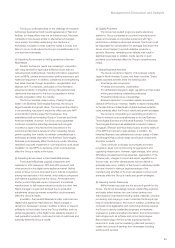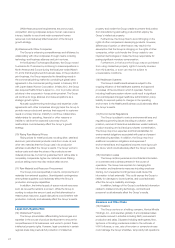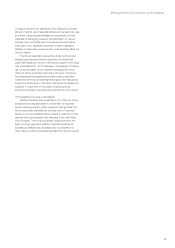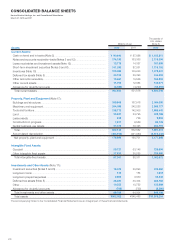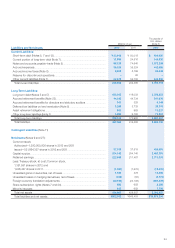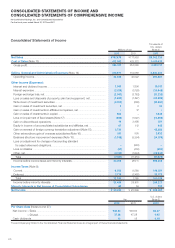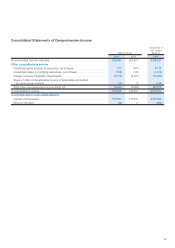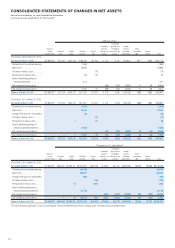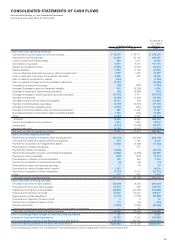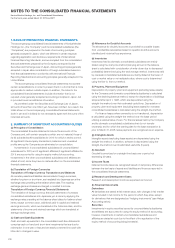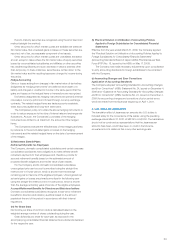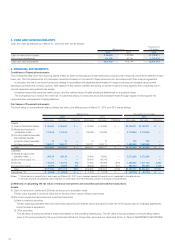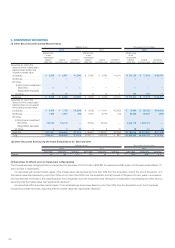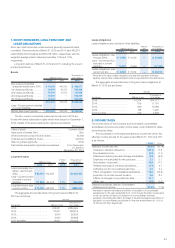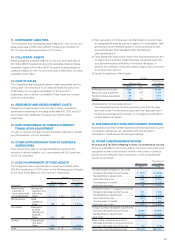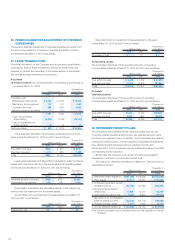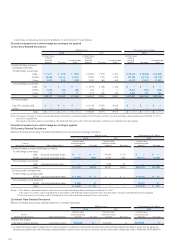Konica Minolta 2012 Annual Report Download - page 31
Download and view the complete annual report
Please find page 31 of the 2012 Konica Minolta annual report below. You can navigate through the pages in the report by either clicking on the pages listed below, or by using the keyword search tool below to find specific information within the annual report.30
Held-to-maturity securities are recognized using the amortized cost
method (straight-line method).
Other securities for which market quotes are available are stated at
fair market value. Net unrealized gains or losses on these securities are
reported, net of tax, as a separate component of net assets.
Other securities for which market quotes are unavailable are stated
at cost, except in cases where the fair market value of equity securities
issued by unconsolidated subsidiaries and affi liates or other securities
has declined signifi cantly and such decrease in value is deemed other
than temporary. In these instances, securities are written down to the
fair market value and the resulting losses are charged to income during
the period.
Hedge Accounting
Gains or losses arising from changes in fair market value of derivatives
designated as “hedging instruments” are deferred as an asset or a
liability and charged or credited to income in the same period that the
gains and losses on the hedged items or transactions are recognized.
Derivatives designated as hedging instruments are primarily interest
rate swaps, currency options and forward foreign currency exchange
contracts. The related hedged items are trade accounts receivable,
trade accounts payable and long-term bank loans.
The Companies’ policy is to utilize the above hedging instruments in
order to reduce exposure to the risks of interest rate and exchange rate
fl uctuations. As such, the Companies’ purchases of the hedging
instruments are limited to, at maximum, the amounts of the hedged
items.
The Companies evaluate the effectiveness of their hedging activities
by reference to the accumulated gains or losses on the hedging
instruments and the related hedged items on the date of commencement
of the hedges.
(l) Retirement Benefi t Plans
Retirement Benefi ts for Employees
The Company, domestic consolidated subsidiaries and certain overseas
consolidated subsidiaries have obligations to make defi ned benefi t
retirement payments to their employees and, therefore, provide for
accrued retirement benefi ts based on the estimated amount of
projected benefi t obligations and the fair value of plan assets.
For the Company and its domestic consolidated subsidiaries,
unrecognized prior service cost is amortized using the straight-line
method over a 10-year period, which is shorter than the average
remaining years of service of the eligible employees. Unrecognized net
actuarial gains or losses are primarily amortized in the following year
using the straight-line method over a 10-year period, which is shorter
than the average remaining years of service of the eligible employees.
Accrued Retirement Benefi ts for Directors and Statutory Auditors
Domestic consolidated subsidiaries recognize a reserve for retirement
benefi ts for directors and statutory auditors based on the amount
payable at the end of the period in accordance with their internal
regulations.
(m) Per Share Data
Net income per share of common stock is calculated based on the
weighted-average number of shares outstanding during the year.
Cash dividends per share for each year as disclosed in the
accompanying consolidated fi nancial statements are dividends declared
for the respective year.
(n) Practical Solution on Unifi cation of Accounting Policies
Applied to Foreign Subsidiaries for Consolidated Financial
Statements
Effective from the year ended March 31, 2009, the Company applied
the “Practical Solution on Unifi cation of Accounting Policies Applied to
Foreign Subsidiaries for Consolidated Financial Statements”
(Accounting Standards Board of Japan (ASBJ) Practical Issues Task
Force (PITF) No. 18, issued by the ASBJ on May 17, 2006).
The Company has made necessary adjustments upon consolidation
to unify accounting standards for foreign subsidiaries to be consistent
with the Company.
(o) Accounting Changes and Error Corrections
Application of Accounting Standards
The Company adopted “Accounting Standard for Accounting Changes
and Error Corrections” (ASBJ Statement No. 24, issued on December 4,
2009) and “Guidance on Accounting Standard for Accounting Changes
and Error Corrections” (ASBJ Guidance No. 24, issued on December 4,
2009) for accounting changes and corrections of prior period errors
which are made from the fi scal year beginning on April 1, 2011.
3. U.S. DOLLAR AMOUNTS
The translation effect of Japanese yen amounts into U.S. dollars is
included solely for the convenience of the reader, using the prevailing
exchange rate at March 31, 2012, of ¥82.19 to U.S.$1.00. The translations
should not be construed as representations that the Japanese yen
amounts have been, could have been, or could in the future be,
converted into U.S. dollars at this or any other exchange rate.


